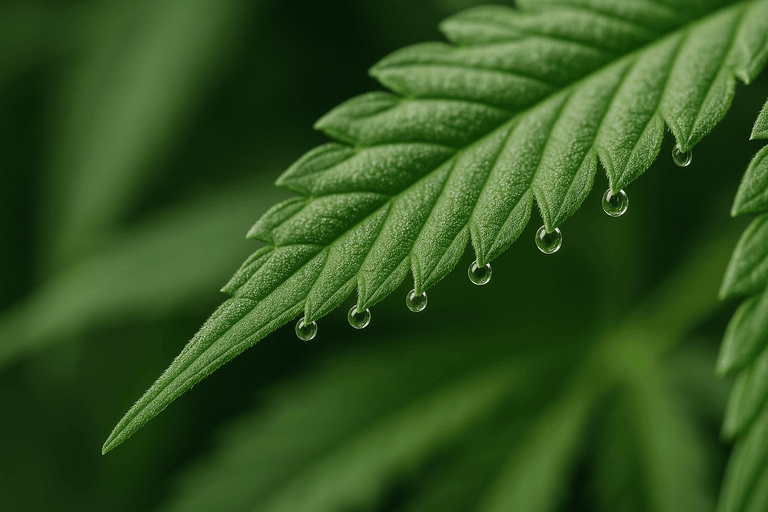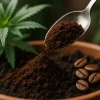Guttation in Cannabis: A Grower’s Guide to Leaf Edge Droplets

Cannabis guttation is one of those moments that can catch beginners off guard. Waking up to find beads of droplets on cannabis leaves can look strange and even alarming. Many growers immediately wonder whether the plant is sweating, leaking resin or showing early signs of mold. The truth is much simpler. Cannabis guttation is a natural way for cannabis to release excess moisture, and once you understand why it happens, it becomes a helpful indicator of plant health, hydration patterns and environmental balance rather than a cause for panic.
What Cannabis Guttation Actually Is
Guttation occurs when a plant pushes out small, watery or slightly sticky droplets through specialized pores on the leaf margins called hydathodes. This happens mostly at night. During the dark cycle, the stomata close and the plant’s primary water-release pathway shuts down, yet the roots may continue absorbing moisture from the medium. When internal root pressure rises beyond what the plant can comfortably hold, cannabis guttation acts as a natural release valve. The droplets contain water mixed with tiny amounts of sugars, minerals and organic compounds, which explains the faint white residue that may appear after they dry.
How Guttation Differs From Dew and Resin
Growers often confuse guttation with dew or resin. Once you know the differences, identifying it becomes effortless.
Guttation
- forms along leaf edges during the night
- feels watery or lightly sticky
- dries into pale mineral spots
Dew
- forms when humidity condenses on cool leaf surfaces
- appears anywhere on the leaf
- evaporates cleanly
Resin
- found only on buds and sugar leaves
- sticky, aromatic and rich in cannabinoids
- forms in trichomes, not droplets
If clear droplets sit neatly on the serrations of fan leaves after lights off, you are very likely looking at cannabis leaf guttation rather than dew or resin. For growers who have never seen it before, guttation droplets often look like tiny glass beads lined up along the leaf edges. When they dry, they may leave a thin, sugary film that resembles a light white dusting on the serrations.
Why Cannabis Produces Guttation
To understand guttation, it helps to look at how water moves through cannabis throughout the day. In the light cycle, roots absorb water, the stomata open and leaf moisture escapes through transpiration. This upward pull keeps water circulating and allows the plant to regulate internal pressure.
At night, everything shifts. Stomata close, photosynthesis stops and transpiration slows almost to zero. The roots may still absorb moisture, but the plant has no normal outlet for it. If this intake exceeds what the plant can store, internal pressure builds. Cannabis guttation is the plant’s way of relieving that pressure and keeping itself safe.
Common Conditions That Trigger Guttation
Frequent cannabis guttation often means the environment needs a bit of adjustment. The most common triggers include:
- watering too often or letting the medium stay wet
- poor drainage in compact soil or plastic pots
- watering too close to lights off
- high nighttime humidity
- sharp temperature drops after lights out
- mineral buildup or high EC in the root zone
These factors all increase root pressure and make guttation more likely.
Is Guttation Harmful to Cannabis?
The droplets themselves are harmless, but the conditions that produce them can cause problems over time. Because the liquid contains sugars, it can feed mold spores on the leaf surface if airflow is weak or humidity is high. Frequent guttation can also raise canopy humidity and hint at nutrient imbalance or overwatering. None of this causes immediate damage, but it does signal that the plant is working under conditions that deserve attention.
How to Reduce or Prevent Guttation
Most growers resolve cannabis guttation quickly with simple environmental adjustments. Allow the medium to dry more thoroughly between waterings, especially in soil. Improve drainage with lighter mixes or fabric pots so the roots receive enough oxygen. Maintain gentle nighttime airflow and keep humidity within a stable range of 50 to 60 percent. If your grow room experiences dramatic temperature drops, softening the transition helps the plant rely on normal transpiration instead of guttation. When salt buildup is suspected, a light flush restores balance in the root zone.
How Different Growing Mediums Influence Guttation
Each growing medium handles moisture differently. Soil holds water longer, so overwatering or compacted mixes often lead to guttation and water droplets forming on leaf edges. Coco encourages frequent feeding, which can push beginners toward watering more than necessary. Hydroponic systems experience less guttation, but cold nutrient solution, poor root oxygenation or high EC levels can still create enough internal moisture pressure to trigger cannabis guttation. Understanding how your medium behaves helps prevent repeated guttation events.
What Guttation Reveals About Plant Health
Cannabis guttation offers useful insight into the internal conditions of your plant. Frequent guttation signals strong root pressure, excess moisture availability or a saturated medium. When droplets dry into visible crystals, it suggests the plant is pushing out excess salts. If guttation appears mainly in humid pockets of the canopy, it hints at a microclimate that could support mold. And when guttation repeats night after night, it shows that the plant is relying on emergency moisture-release pathways instead of normal transpiration. These signs help growers refine their environment before problems escalate.
A Natural Response and a Helpful Message
Cannabis guttation may surprise you the first time you see it, but once you understand what it represents, it becomes a helpful signal rather than a concern. Occasional guttation is normal. Frequent guttation means the plant is asking for adjustments in watering, airflow or humidity. When the environment is stable, the droplets fade on their own and the plant grows stronger and more predictable throughout the entire cycle.
A plant that occasionally guttates is not in danger. A plant that does it frequently is simply telling you that the environment needs a little attention.
FAQ
How do I know if it’s guttation and not dew or resin?
Guttation forms along the leaf edges during the night and dries into pale mineral spots. Dew can appear anywhere on the leaf and evaporates cleanly, while resin forms only on buds and sugar leaves and is sticky and aromatic. If clear droplets sit neatly along the serrations after lights off, it is almost always cannabis guttation.
Does guttation mean my plant is overwatered?
Not necessarily, but overwatering is one of the most common triggers. When the medium stays wet for a long time or drainage is weak, root pressure rises and guttation becomes more likely.
Is guttation normal in cannabis plants?
Yes. Occasional guttation simply reflects active roots and nighttime moisture pressure. If it happens regularly, the environment probably needs adjustment.
Are guttation droplets dangerous for humans, and can you taste them?
Guttation droplets are not dangerous, but tasting them has no purpose. They are mostly water mixed with sugars and minerals, contain no cannabinoids and should not be consumed. They are not part of the plant’s resin or trichome production.
Can guttation cause problems for my plants?
The droplets themselves do not harm the plant, but the sugars they contain can support mold growth in humid conditions. Frequent guttation may also raise canopy humidity and signal an imbalance in the environment.
How can I stop guttation in my grow room?
Let the medium dry properly, avoid watering before lights off, improve drainage, maintain gentle airflow at night and keep humidity stable. Reducing sharp temperature drops after lights out also helps the plant regulate moisture normally.



Thank you for leaving a comment for us!
Your feedback will be posted shortly after our moderator checks it.
Please note that we don’t publish reviews that: